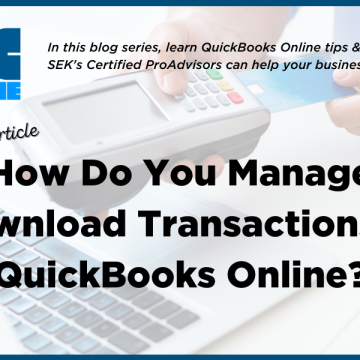What’s “fair value” in an accounting context?
In recent years, the accounting rules for certain balance sheet items have transitioned from historical cost to “fair value.” Examples of assets that may currently be reported at fair value are asset retirement obligations, derivatives and intangible assets acquired in a business combination.
Look at your employee handbook with fresh eyes
For businesses, so much has changed over the past year or so. The COVID-19 pandemic hit suddenly and companies were forced to react quickly — sending many employees home to work remotely and making myriad other tweaks and revisions to their processes.
Do you know the new accounting rules for gifts in kind?
If your not-for-profit organization accepts contributions of nonfinancial assets, such as land, services and supplies, you should know about Financial Accounting Standards Board (FASB) rules approved last year.
How Do You Manage Downloaded Transactions in QuickBooks Online?
Downloading them is the easy part. QuickBooks Online lets you work with downloaded transactions in numerous ways.
Providing education assistance to employees? Follow these rules
Many businesses provide education fringe benefits so their employees can improve their skills and gain additional knowledge.
Minimize the need to make year-end financial adjustments
If your not-for-profit periodically prepares internal financial statements for your board, you may have noticed that your auditors propose adjustments to these interim statements at year end. Why do auditors do this? Generally, it reflects differences due to cash basis vs.
Claiming the business energy credit for using alternative energy
Are you wondering whether alternative energy technologies can help you manage energy costs in your business? If so, there’s a valuable federal income tax benefit (the business energy credit) that applies to the acquisition of many types of alternative energy property.
Should a tax apportionment clause be in your estate plan?
Even though the federal gift and estate tax exemption is currently very high ($11.7 million for 2021), there are families that still have to contend with significant federal estate tax liability.
D&O insurance: How nonprofits can reduce liability risk
Not-for-profit organizations may operate under the assumption that their missions and their board members’ good intentions protect them from litigation. Sometimes, this assumption is proven wrong with a lawsuit.
Protect your organization’s fragile tax-exempt status
Not-for-profit organizations are different from for-profit businesses in many vital ways. One of the most crucial differences is that under Section 501(c)(3), Sec. 501(c)(7) and other provisions, nonprofits are tax-exempt. But your tax-exempt status is fragile.









